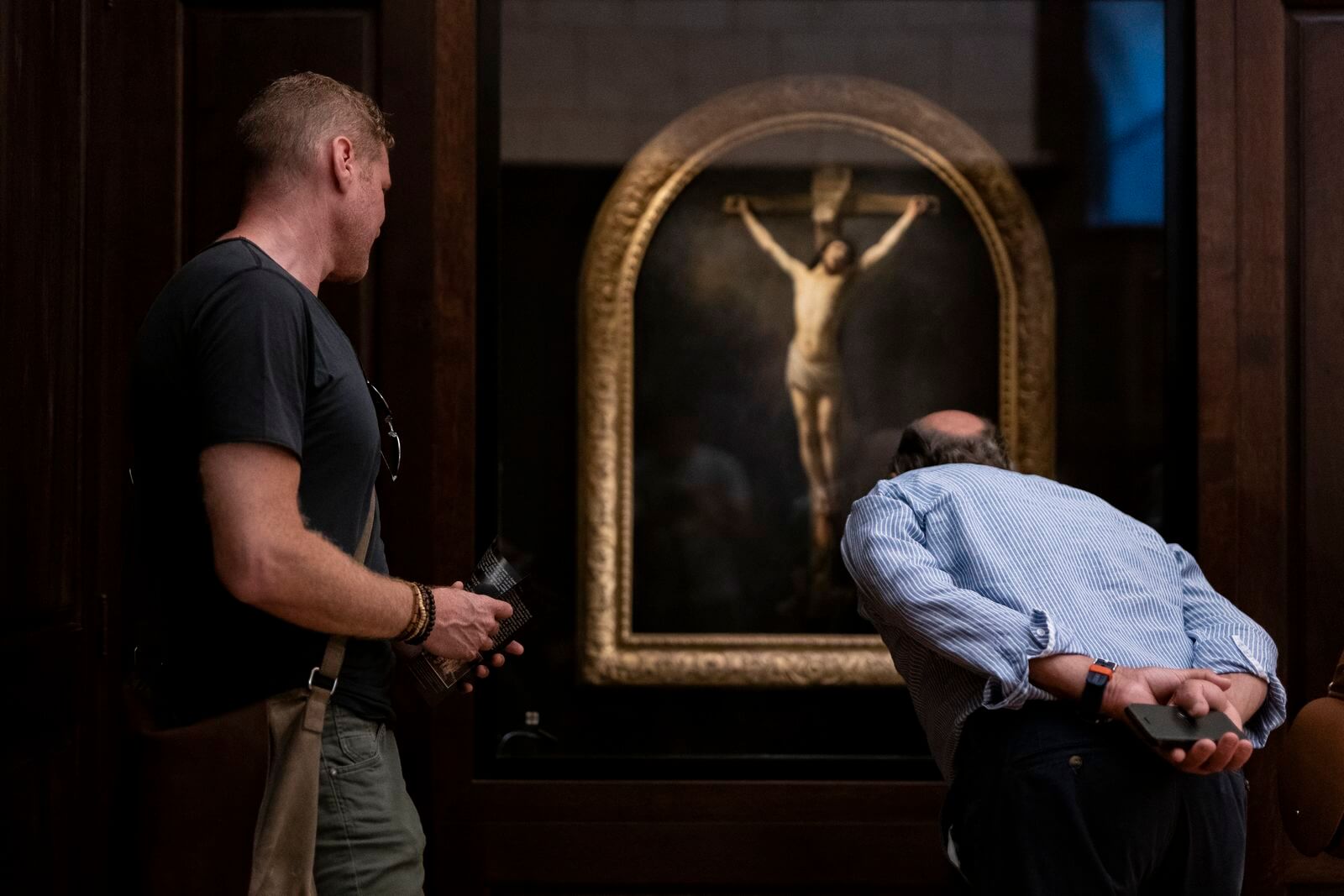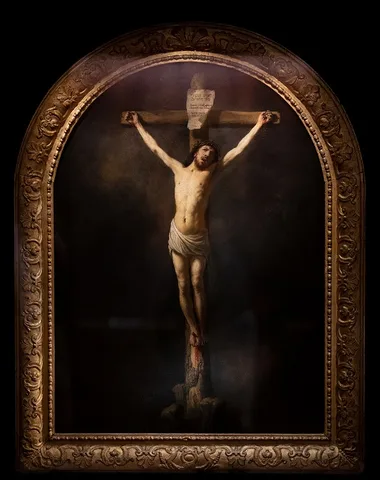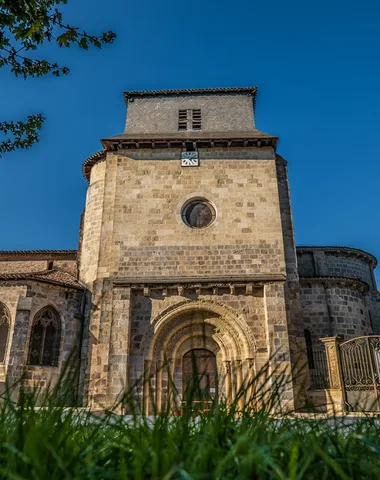Christ on the Cross by Rembrandt Harmenszoon van Rijn (1606/1607 – 1669), known as “Rembrandt”.
Christ on the Cross by Rembrandt is an oil painting on wooden panel, measuring 100 by 73 cm, completed in 1631. Rembrandt was twenty-five years old at the time.
REMBRANDT IN HIS TIME
Having gained some recognition as a painter, he received numerous commissions for portraits and left Leiden to settle in Amsterdam. The city converted to the Reformation in 1578, shortly before the creation of the Republic of the United Provinces in 1579. In the 1633th century, in a Protestant context, artists favored secular scenes. However, tolerance remains towards Catholic worship, and many artists continue to represent Christ, in works intended for churches, as well as for private devotion. The circumstances of Christ's commission on the Cross, as well as the sponsor, are unknown. The format of the painting, however, suggests that it is a painting of private devotion, painted to be seen up close. The work could be compared to the series of seven paintings on the theme of the Passion, created by Rembrandt between 1639 and XNUMX for Prince Frederick Henry of Orange Nassau. Six of them are now kept in the Munich Pinakothek.

THE WORK
In this painting, the body of Christ stands out against a dark landscape. At the top of the cross is nailed an inscription in Greek, Latin and Hebrew: “Jesus of Nazareth, king of the Jews”, alluding to the text that Pontius Pilate had placed on the cross (John 19, 19). Christ's head, crowned with thorns, leans on his shoulder (figure 1). Blood flows from his hands and feet, nailed to the cross. With furrowed eyebrows, furrowed brow, open mouth, face twisted in pain, Christ is in agony: “From the sixth hour (i.e. noon), darkness fell over all the earth until the ninth hour. About the ninth hour Jesus cried with a loud voice, Eli, Eli, lema sabactani? which means, my God, my God, why have you forsaken me? » (Matthew 27, 45-46). In this moment of suffering and isolation, the body of Christ is nevertheless bathed in light, such as an evocation of the resurrection to come.
THE REPRESENTATION OF CHRIST IN THE XNUMXTH CENTURY
At the time of Rembrandt, the most widespread image of Christ was still that of Byzantine icons, that of a man with fine features, a long nose and thin lips. When Christ is represented on the cross, he remains glorious, impassive in the face of death, like Christ on the Cross by Jan Lievens, whose studio Rembrandt shared in Leiden, which was also painted in 1631 (figure 2). Twenty years earlier, Rubens had created a Descent from the Cross which differed from this traditional iconography (figure 3). Rubens' Christ, with his muscular body, evokes the ideal of the heroes of Antiquity. Rembrandt's Christ, for his part, bears no resemblance to traditional representations, nor to the ancient ideal of Rubens. In the words of Blaise Ducos, curator at the Louvre, this is a true “iconographic revolution”: Rembrandt depicts a sickly, miserable being with a tormented face. Christ on the Cross is reminiscent of the studies of expression carried out by Rembrandt, particularly in engraving (figure 4). Christ is therefore no longer an archetype, but an individual, a man whose suffering must arouse the spectator's empathy. Rembrandt highlights the human nature of Christ, rather than his divinity. The artist will represent Christ on the cross again in 1653 in a famous engraving, The Three Crosses (figure 5), a work of great dramatic intensity, where the spectator is this time kept at a distance, separated from the luminous figure of Christ by the stirrings of the crowd.
THE ARRIVAL OF THE PAINTING AT MAS D’AGENAIS
In 1703 the work belonged to Catharina Elisabeth Bode, widow of Valerius Röver in Delft, because an inventory of her possessions made that year contained a “Rembrandt Christ on the Cross”. An auction in 1781 in Bruges then mentions a work from the collection of Marie-Alexandrine de Fraula, widow of Philippe de Schietere, representing “Jesus Christ attached to the cross… painted in the year 1631, by Rembrandt” . These two references indicate that the author and the date of execution of the painting are known. In 1804, Xavier Duffour, captain of the imperial armies, originally from Mas d'Agenais, acquired the painting in Dunkirk; he donated it to the parish the following year. The painting, in the 1905 inventory, was classified as a Historic Monument on June 6, 1918. In 1959, a restoration by the laboratory of the national museums revealed, thanks to an x-ray, Rembrandt's signature under the feet of the
Christ: RHL 1631 (for Rembrandt Harmenszoon of Leiden). This suggests that the signature was once covered up, for an unknown reason.
THE TECHNICAL ASPECTS OF THE TABLE
The painting was studied in 2011 by Isabelle Leegenhoek, in the restoration workshops of the Center for Research and Restoration of the Museums of France, in order to be exhibited at the Louvre Museum during the exhibition “Rembrandt and the figure of Christ » (April-July 2011). Analyzes from 2011 reveal that the painting is probably not an oil on canvas mounted on wood, as was previously believed, but a work on wood which would have been transposed onto a new panel in the 2011th century. The restorer thus reveals the very fine weave of the transposition gauze, and the preparation of the work, characteristic of Rembrandt's preparations on wood, and not on canvas. The painting being very fragile, only cleaning could be carried out in 2021. In 70, on the occasion of the restoration of the Collegiate Church, a new presentation was designed in order to improve its conservation, its safety and its presentation . To avoid a change in the climatic conditions to which the painting has become accustomed since the 95th century, the window includes natural ventilation, which will follow the evolution of the climate in the collegiate church: a relative humidity of between 5 and 20% and variations in temperature. temperature from XNUMX to XNUMX° depending on the seasons.
DRAC Nouvelle-Aquitaine 2022











